- Home Page
- Accessories
- Kite Winder
The MBK150 Kite Winder
For the 2-Skewer and Dowel Kites
For some time we had used simple 30-centimeter (12-inch) long kite-winders for most of our flying. That size proved just right for storing 150 meters (500 feet) of flying line.
The legal altitude limit in Europe is 150 meters, 80 in the UK (poor beggars). In the USA it's 500 feet, while in Australia it's 120 meters (400 feet) above the ground. We used the 50-meter line for the 1-Skewer kites and occasionally for test flying a new 2-Skewer kite.
Described here is a refinement of the 150-meter winder we used most, in two versions. Can I be a bit pompous and call it the MBK150 Kite Winder.
Not all flat winders are great for letting out line quickly, but I put some thought into getting this winder to do just that.
On this site, there's more kite-making info than you can poke a stick at. :-)
Want to know the most convenient way of using it all?
The Big MBK E-book Bundle is a collection of downloads—printable PDF files which provide step-by-step instructions for many kites large and small.
Every kite in every MBK series.
First, for those in a real hurry, I will describe how to
bang out a crudely finished winder that holds the same amount of line
and has a similar ability to let out line continuously. To give it a
name, let's call it the Quick Winder.
Second, I go on to describe extra steps to turn the quick winder into something much nicer to handle and use. It looks a darn sight better too! This one can be called the Nice Winder. There's a picture of it down there.
Now, I'm not an experienced wood-worker, so feel free to do the finishing work your own way if you can do a better job!
Rather than bore you with a bunch of long paragraphs, here's three lists that describe this kite-string winder:
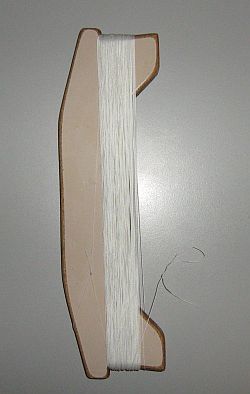
Features
- designed for 150 meters of 20- to 50-pound line with room to spare; it would also suit 50 meters of 100- to 200-pound line
- saw-cut angle is designed to help line stay in place for storage yet slip off easily when letting out line quickly in fresh wind
- cutout takes some of the weight out of it for extra comfort
- cutout doubles as a finger grip when most of the line is out
- sturdy to tolerate a fair amount of line stored under tension
- most of the work is done with saw cuts, leaving a minimum of filing and sanding
Materials
- hardwood or heavy chip-board plank around 1.5 cm (3/4 in.) thick and at least 30 cm (12 in.) long and 9 cm (3 3/8 in.) wide
- for the Nice Winder, some dark wood stain (optional) and wood lacquer
Tools Required
- pencil or marking pen, and ruler
- medium-grade woodworking file
- a wood saw—a full-size one is fine
- for the Nice Winder, a sheet each of "very coarse," "medium," and "fine" sand paper (or "glass paper" as it is now)
- also for the Nice Winder, a brush for applying lacquer although you could use a piece of rag
MBK150 Kite Winder Plan
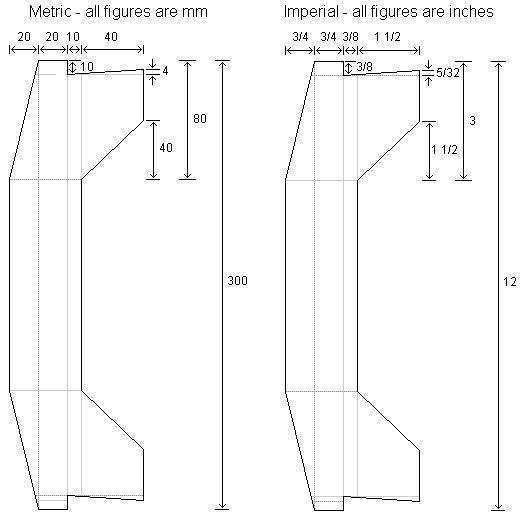
Making the Quick Kite Winder
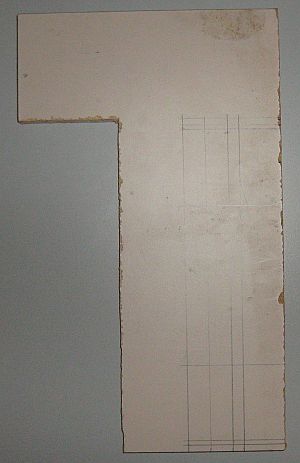
1. Referring to the plan, mark dots on the board, representing all the corners of the winder. Then rule straight lines between them as in the photo.
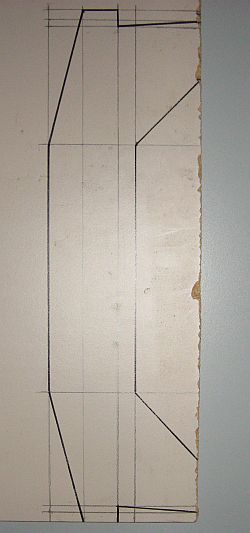
2. Now draw in the outline of the winder. I've used a black marking pen just so it shows up better in the photo.
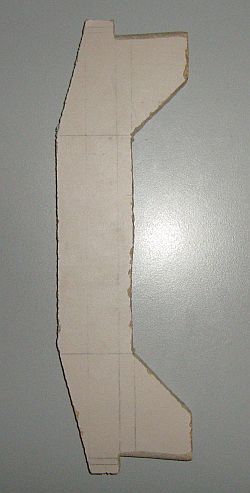
3. Cut along all the lines with the wood saw.
Using the file, round off the four edges that will come into contact with the flying line when it's wound on. Take plenty of wood off so the line doesn't have to go around any sharp bends.
That's it for the Quick version. If that's all you want to do, skip straight down to the section titled The Flying Line. Otherwise...
Making the NICE Kite Winder!
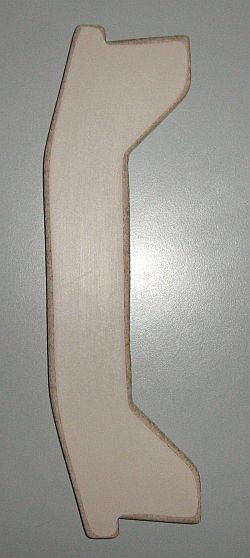
- Round all the edges with the file, for handling comfort.
- Go over all of the winder with the coarse sheet of sandpaper, to take out any file marks..
- Go over it all again, with the medium sandpaper.
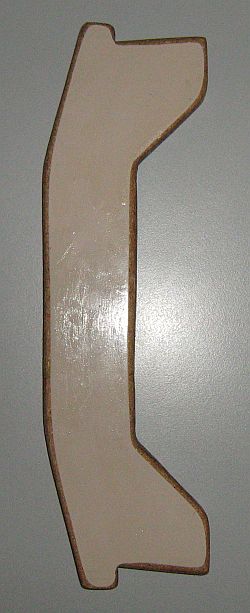
- I used a piece of heavy chipboard that had plastic veneer bonded to each side—so I skipped the dark wood-stain! If you are using wood, use the wood stain on it now.
- After the stain is dry, apply a coat of wood lacquer. I used a polyurethane gloss product, which is supposed to be pretty hard-wearing.
- Allow to dry completely.
- Sand all over, lightly, with the light sandpaper.
- Apply another coat of lacquer and allow to dry.
That's it, the finished article!
The Flying Line
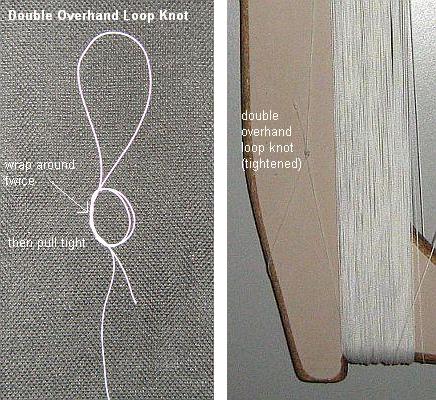
Just like we did with the 50-meter winder, the line is designed to be easily taken off the winder, if necessary, and attached to something else. For example, it could go to another kite as part of a "kite train."
Put a large double overhand loop into one end of 150 meters (500 feet) of flying line. See the photo on the left. Our Skewer Series kites go well on 20-pound nylon or Dacron, while 50-pound line is safer for the Dowel Series kites.
Loop the line over one horn of the winder (see the photo on the right), and wind on all the remaining line.
Put a double overhand loop into the free end of the line.
Have you ever wondered just how much line has been let out?
 Length tags
Length tagsHere's a tip! Before winding 150 meters of new 50-pound braided Dacron onto its winder, I measured it out in 30-meter (very close to 100-foot) lengths on the back lawn.
I then tagged the line every 30 meters with a small square of colored electrical insulation tape as shown in the photo. The tape was placed diagonally then folded over and pressed together to form a triangle.
Here's the color sequence, measured from the kite end:
- 0 meters (0 feet): full kite winder
- 30 meters (100 feet): white tag
- 60 meters (200 feet): yellow tag
- 90 meters (300 feet): blue tag
- 120 meters (400 feet): black tag
- 150 meters (500 feet): empty kite winder, so leave a few turns on!
Of course, the black tag is the first to go on, when making up the line onto the kite winder.
To make the lengths easier to remember, the colors get darker with every 30 meters. I suppose you could mark the lengths on the tags themselves if you really wanted to!
So if the kite is directly overhead in a thermal, you have a good idea how close you are to the legal limit. The black tag marks the limit in Australia and an empty winder elsewhere in the world, basically.
At the Kite End
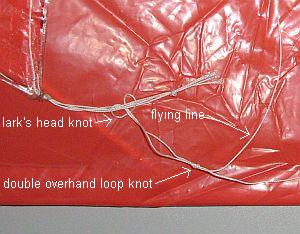
The photo shows the line attached to the keel of a kite, using a
Lark's Head knot. The knot is left loose to illustrate how it's done.
Can you guess which kite it is?
As mentioned earlier, there's more kite making on this site than you can poke a stick at. :-)
Want to know the most convenient way of using it all?
The Big MBK E-book Bundle is a collection of downloads—printable PDF files that provide step-by-step instructions for many kites large and small.
That's every kite in every MBK series.
